Get Certified: Lead Auditor & Implementer Training on ISO 9001, 14001 & 45001 Documentation Process Begins
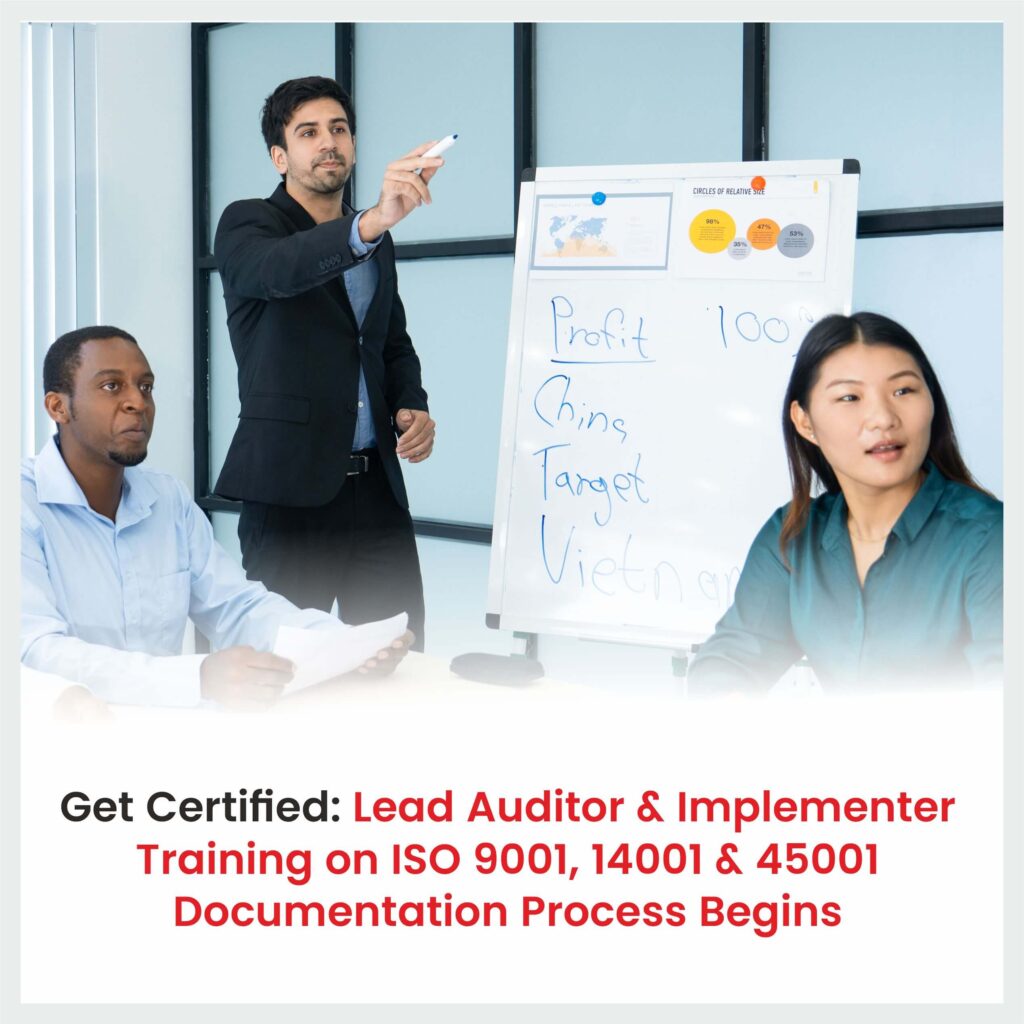
SIS Certifications Announces Comprehensive Five-Day Training Program for Quality, Environmental, and Occupational Health & Safety Management Systems Professional certification opportunity available both online and onsite SIS Certifications, a leading provider of management system training and certification services, is excited to announce the launch of its intensive Lead Auditor & Implementer Training program covering three crucial ISO standards: ISO 9001 (Quality Management), ISO 14001 (Environmental Management), and ISO 45001 (Occupational Health and Safety Management Systems). This comprehensive five-day training program is designed to equip professionals with the essential skills and knowledge needed to successfully implement and manage integrated management systems within their organizations. The training will focus specifically on the documentation processes that form the backbone of effective ISO compliance. Training Schedule and Format The Lead Auditor & Implementer Training will take place over five consecutive days : Dates: August 21st, 22nd, 23rd, 24th, and 25th, 2025 Time: 10:30 AM to 6:30 PM daily Mode: Available both online and onsite to accommodate different learning preferences and geographical constraints This flexible approach ensures that working professionals can participate regardless of their location or schedule constraints. Participants can choose between attending virtually through our advanced online platform or joining us in person at our training facility. What Makes This Training Special The program stands out by covering three major ISO standards in one integrated course, providing participants with a holistic understanding of how quality, environmental, and safety management systems work together. This integrated approach is particularly valuable in today’s business environment where organizations are increasingly adopting multiple management standards simultaneously. “Many organizations today implement multiple ISO standards, but they often struggle with creating cohesive documentation that serves all three systems effectively,” says a spokesperson from SIS Certifications. “Our training addresses this challenge by teaching participants how to develop integrated documentation processes that satisfy all three standards while reducing redundancy and complexity.” Who Should Attend This training is ideal for quality managers, environmental coordinators, safety officers, compliance professionals, consultants, and anyone responsible for implementing or maintaining ISO management systems. No prior experience with ISO standards is required, making it accessible to newcomers while still providing advanced insights for experienced professionals. Training Highlights Participants will gain hands-on experience in: Understanding the requirements of ISO 9001, 14001, and 45001 Developing integrated documentation strategies Creating effective policies and procedures Implementing risk-based thinking across all three standards Conducting internal audits and management reviews Preparing for certification audits The training combines theoretical knowledge with practical exercises, case studies, and real-world examples to ensure participants can immediately apply what they learn in their workplace. Certification Benefits Upon successful completion, participants will receive a Lead Auditor & Implementer certificate recognized internationally. This certification demonstrates competency in implementing multiple ISO management standards and significantly enhances professional credentials in the quality, environmental, and safety fields. Registration Information Interested professionals can register for either the online or onsite version of the training. Early registration is recommended as seats are limited to ensure personalized attention and interactive learning experiences. For registration details or inquiries: 📞 Contact Us: +91-8882213680 🌐 More Info: https://www.siscertifications.com/iso-training/ 📧 Email: [email protected] About SIS Certifications SIS Certifications is a leading provider of professional certification training with particular expertise in information security standards and frameworks. SIS Certification is accredited by the International Accreditation Services (IAS-IAF), United Accreditation Foundation (UAF) Services and Exemplar Global, and we would be happy to help you get started. SIS Certification delivers world-class management system certification and professional training services across multiple industries. With a presence in over 15 countries and a team of experienced auditors and trainers, SIS helps organizations build robust quality, safety, and environmental management systems that ensure compliance and drive continuous improvement.
What are the requirements of ISO 41001:2018 Certification?
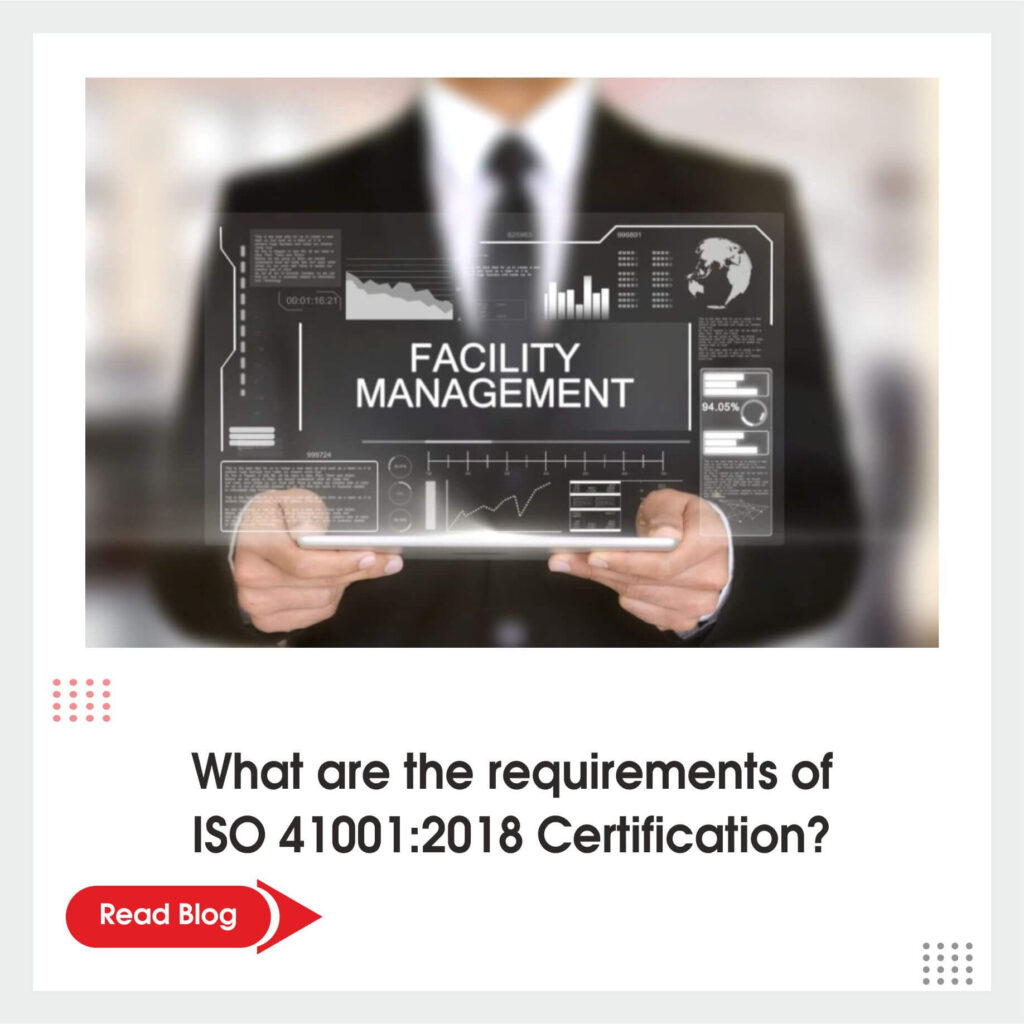
The ISO 41001 standard amalgamates individuals, locations, and procedures within constructed spaces to improve occupants’ experiences and boost business productivity. However, the International Organisation for Standardisation (ISO) released the ISO 41001 for Facility Management System (FMS) in 2018. The certification is suitable for organisations, including public or private, irrespective of their size, scope, or geographical remoteness. Furthermore, the ISO 41001 standard is crafted to address the growing intricacies of facility management. Why should an organisation apply for ISO 41001:2018 Certification? ⮯ ISO 41001 is the first international facility management system (FMS) 41001 standard in the world. Facility management is an organisational function that combines people, place, and process to enhance the built environment’s quality of life and the productivity of the company’s main business. ISO 41001 certification constructs a comprehensive environment for buildings, external works, and infrastructure in a given area. It improves quality of life by raising safety standards and improving working conditions for those who operate in the built environment, for example, walkways, walls, buildings, electrical and mechanical systems, and more. However, implementing ISO 41001 enhances the productivity of core company operations. Furthermore, it focuses on improving societal services, including healthcare, education, retail centres, hotels, condos, and hospitality, among other areas. Which organisations can apply for ISO 41001 Certification? ⮯ ISO 41001 helps organisations adopt an adequate facility management system to build safe communities and attain sustainable growth. Here is a list of organisations that can apply for ISO 41001 standard: Requirements of ISO 41001 standard ⮯ ISO 41001 is an internationally recognised standard for Facility Management systems that improves and modernises an organisation. The ISO 41001 has ten requirements, and out of these, seven requirements are mandatory. These are: Section 4: Context of the organisation This section deals with understanding the requirements of an organisation for implementing the appropriate Facility Management System. It also helps organisations to tailor the FMS as per the organisational requirements. Section 5: Leadership This clause focuses on the importance of top management in the FMS implementation. Every individual within the organisation must understand their specific duties and responsibilities to adopt an effective FMS. Section 6: Planning The planning clause entails risk analysis and system analysis to reduce risks and establish goals for an efficient FMS. It also mandates organisations to examine its interaction with itself at all levels and through various channels. Section 7: Support This clause mandates an organisation to arrange all the required resources to establish an effective FMS, from implementing a system to overseeing documented information within the organisation to allocating resources. Section 8: Operation Clause 8 of ISO 41001 addresses the operational specifications for facility management. Moreover, it also entails getting the company ready for any unforeseen circumstance. Section 9: Performance Evaluation It guaranteed the effectiveness of an FMS. Moreover, this part monitors things to evaluate the system and pinpoint areas that could use improvement. Section 10: Continuous Improvement Section 10 of ISO 41001 guarantees the effectiveness of the FMS. Organisations ensure ongoing evaluations of their compliance with the ISO 41001 standard. Conclusion ✅ The International Organisation for Standardisation (ISO) has released ISO 41001:2018 as a global standard for the Facility Management System (FM) into practice in businesses. Moreover, it deploys the most upgraded standards for facility management within the organisation. Since the frameworks for ISO 45001, ISO 9001, and ISO 14001 certifications are the same, it is simpler to integrate all of these management systems.
Benefits of ISO 22000:2018 Certification
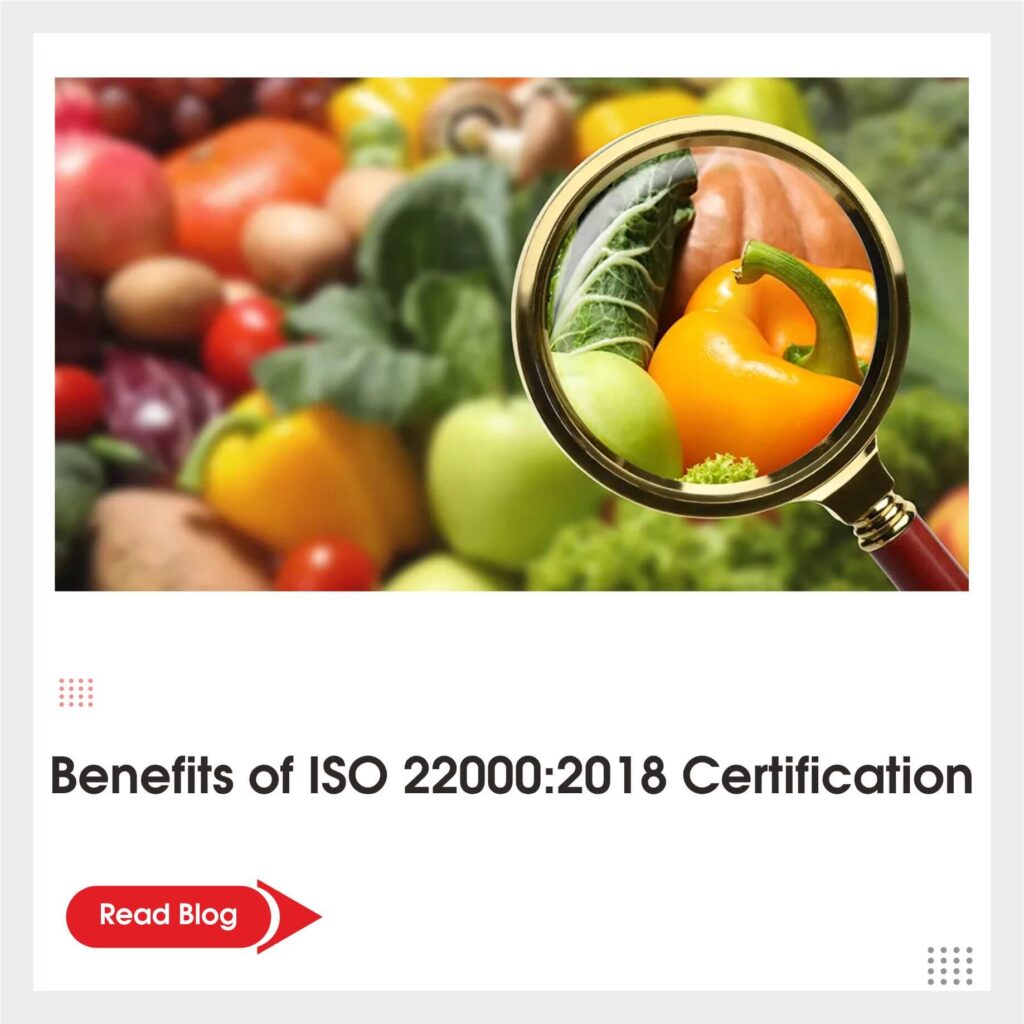
An organisation that operates by the standards created and disseminated by the International Organisation for Standardisation (ISO) can receive ISO Certification. However, an ISO Certification is a kind of endorsement from an impartial third party. The advantages of various ISO Standards and Certifications vary, as an organisation involved in the food chain can implement the Food Safety Management System required by ISO 22000 certification. The advantages of ISO 22000 certification for the food industry are covered in this article. What is ISO 22000:2018 Certification? ⮯ The independent organisation ISO issues ISO Certifications. Furthermore, it exhibits a company’s compliance with any standards established by the International Organisation for Standardisation. It is an independent, non-governmental organisation that brings experts together to share knowledge and create international standards that address pressing global issues. Although promoting trade is its principal objective, process improvement, safety, and quality are also important considerations. ISO 22000:2018 outlines the requirements for the international standard for Food Safety Management Systems (FSMS). Its goal is to assist businesses in the food sector in guaranteeing the safety of their goods. The standard incorporates management standards, prerequisites, and Hazard Analysis and Critical Control Points (HACCP) and covers the whole food chain, from production to final consumption. Businesses with ISO 22000:2018 certification can show their clients and other stakeholders that they have a comprehensive food safety management system. Ways in which a Food Safety Management System (FSMS) helps organisations achieve a safe and sustainable food supply chain ISO 22000 standard is a widely used framework for food safety that assures clients and customers that a particular organisation follows national and international best practices. Moreover, the standard is based on the seven HACCP principles to ensure an effective food safety management system. ISO 22000 and HACCP together assist organisations in identifying and mitigating risks before they endanger the safety of consumers and food. The seven HACCP principles are as follows:-⮯ Hazard Analysis: Hazard Analysis provides a preventive strategy for food safety by identifying physical, chemical, and biological food safety risks during the production process. Critical Control Point: Critical Control Points (CCPs) provide tools and controls for organisations to use at different points in the procedure to lower the risks to a manageable level. Critical Limit: Every CCP has a maximum and minimum value attached to it to define its safety restrictions. It distinguishes between the harmful or unacceptable product and the safe or acceptable product. Moreover, it measures or observes the food supply chain at various levels to identify and eliminate food safety hazards. Monitoring: It monitors all the techniques and procedures to evaluate their impacts and determine the effectiveness of implemented CCP controls. Corrective Actions: In case an organisation finds a shortcoming or deviation from the defined critical limit, it must implement appropriate tools to address them. Corrective actions demonstrate an organisation’s commitment to attain defined results. Verification: It analyses the effectiveness of a food safety management plan. Moreover, the verification process ensures that the implemented plan appropriately covers and identifies all the areas of danger. Record Keeping and Documentation: An organisation must maintain all the records under Record Keeping and Documentation to establish a smooth and flexible checks and balances system. Moreover, it ensures that the organisation complies with the Food Safety Policy and requirements to avoid errors and discrepancies. Some Key Benefits of ISO 22000:2018 Standard ⮯ Organisations can reduce food safety incidents and recalls by developing a food safety management system that satisfies ISO 22000:2018 requirements. Moreover, this will help them better detect and control food safety concerns. The certification provides a robust food safety management system and helps organisations demonstrate their commitment to identifying and eliminating food safety threats and hazards. Moreover, it boosts customer confidence in the security and calibre of the company’s products. Companies certified to ISO 22000:2018 can use their certification as a marketing tool to improve the company’s brand name and its products’ reputations. ISO 22000:2018 is a widely accepted standard that can assist organisations in adhering to national and international rules and regulations concerning food safety. Organisations can find and rectify inefficiencies and enhance overall operations. As a result, it can save extra costs by implementing a food safety management system. It enables businesses to exert more control over their subcontractors and suppliers as it exhibits dedication to adopting international and national best practices. It also results in a safer and more effective supply chain. Conclusion ✅ The efficacy of a food safety management system is contingent upon the organisation’s unique installation and continued dedication to improving the system. Although ISO 22000 certification indicates that an organisation implements a food safety management system that satisfies food safety requirements, it does not guarantee food safety. To maintain the system’s continued efficacy, the organisation must continue to monitor and review it.
ISO Certification in India- Online Process, Fees, Procedures
The Process of certification starts from filling up of the below form and providing the technical information which is then used to calculate the man-days required for the audit. Once the relevant information is received the same is technically evaluated and the cost and timelines are communicated to the organisation. “We value our clients’ time and respond with urgency, ensuring swift communication and timely delivery of services.” What is ISO Certification? ⮯ The role of the independent organisation ISO- International organisation for Standardisation is to review, update, publish new and old ISO Standard issues the international standard.These standards are then implemented in the organisation to become eligible to apply for certifications. SIS Certifications is one of the prominent and most stable certification body to be applied for ISO Certifications. There are various management system standards- ISO Standards which are valid for ISO Certifications which focus on various parameters of the system in any of the organisation. ISO 9001, ISO 14001, ISO 45001, ISO 22000 , ISO 27001, ISO 27701, ISO 13485, ISO 20000-1 and various other international management system standards. Types of ISO Certifications ⮯ ISO has produced over 22521 international standards that span nearly every sector of the economy, including technology, food safety, services, healthcare, and agriculture. The worldwide impact of ISO International Standards is evident through its increasing demand and significance for businesses. The different types of ISO Certifications are as follows:- ISO 9001:2015 Certification for Quality Management Systems (QMS): It is one of the most popular techniques for creating, carrying out, and upholding a “Quality Management Programme” that applies to any company and is flexible enough to cater to the requirements of organisations of diverse nature and size. ISO 14001:2015 Certification for Environmental Management Systems (EMS): ISO 14001 provides the guidelines for implementing an environmental management system (EMS). It consists of documents, policies, strategies, processes, and procedures that set the broad guidelines for how a business engages with the ecosystem. The 2015 standards have received global approval. ISO 45001:2018 Certification for Occupational Health and Safety Management Systems (OHSMS): ISO 45001 is an occupational health and safety management system. It gives businesses a framework for risk management and enhances OH&S effectiveness. Leadership dedication, employee involvement, risk assessment and hazard identification, legal and regulatory compliance, emergency preparation, incident investigation, and ongoing improvement are integral components. ISO/IEC 27001:2022 Certification for Information Security Management Systems (ISMS): The most recent version of the information security standard, ISO 27001, was released in 2022. It outlines specific requirements while designing an appropriate management system for information security under management control. Organisations that meet the requirements may be certified by an accredited certification body after the audit process. ISO 41001:2018 Certification for Facility Management Systems (FMS): ISO 41001 certification for Facility Management Systems (FMS) demonstrates an organisation’s commitment to provide the required support to deliver effective services. Moreover, it helps an organisation to implement appropriate tools and controls to ensure effective facility management. ISO 22301:2019 Certification for Business Continuity Management System (BCMS): ISO 22301 standard provides a robust and resilient framework for organisations to sustain minimum operation even during crises or unforeseen events. The certification prepares the organisation for unprecedented events or incidents by formulating appropriate recovery and disaster management plans. ISO/IEC 27701:2019 Certification for Privacy Information Management Systems (PIMS): Privacy Information Management System (PIMS) mandates organisations to implement appropriate security controls to safeguard users’ personal and confidential information. However, it also requires an organisation to implement the list of security controls defined in ISO 27002 Certification. ISO 22000:2018 Certification for Food Safety Management Systems (FSMS): The requirements in the document are for a food safety management system (FSMS) for any organisation involved in the food chain, whether directly or indirectly. It proves adherence to relevant legal and regulatory standards for food safety. Click here to know more about certifications and get your organisation certified. Benefits of obtaining an ISO Certification in India ⮯ The benefits of ISO Certification are as follows: Businesses often make the same mistakes again because they lack a process to document good problems as they arise. Maintaining meticulous records of issues, identifying their underlying causes, and having long-term solutions ready are all mandated by ISO. Obtaining an ISO credential, an internationally recognised standard to ensure management methods, will strengthen your business and increase sales. Suppliers to many large communities must hold an ISO authorisation. When workers see that the organisation is committed to cutting waste and putting together the highest calibre, it encourages and grows their confidence. Additionally, ISO mandates that you specify job duties, close skill gaps within your company, and communicate your quality standards to employees. ISO requires you to track, gauge, assess, and monitor how well organisations differentiate administration systems and their working. To create performance measures that let the organisation gauge how successfully it conducts its operations. How can an organisation obtain ISO Certification in India? ⮯ Click here to apply for ISO Certifications. Stages of Audit Stage 1 audit: Once the organisation applies for ISO Certification, SIS Certifications performs the technical review and goes for the stage 1 audit. This includes the verification of the documentation, site, scope and other details provided at the time of application. We at sis certifications understands that no organisation is perfect. We give the gaps identified in the stage 1 and the closure of the gaps is required to qualify stage 1 audit. Stage 2 audit: Once the organisation qualifies the stage 1, we proceed with the audit to verify the implementation of the ISO Standard. The gaps in the implementation are notified to the organisation and the closure of the gaps is required to process the further steps for certifications. Cost of ISO Certification in India Click here to know the cost of the certification. Conclusion ✅ It can be difficult for small businesses and microbusinesses to navigate the complexity of ISO certification. Hence, it becomes necessary for an organisation to consult an ISO certification body to understand the complexities and processes thoroughly. However, acquiring an ISO
How to Identify and Address ISO 9001 Non-Conformities

What is ISO 9001:2015? ISO 9001:2015 is a global standard that specifies the standards for an effective Quality Management System. It specifies the precise processes, procedures, and activities that businesses must develop, implement, maintain, and improve to properly manage the production of goods or the delivery of services. A certificate is issued by a third party to give clients more trust that the company has a system in place to meet their needs. When an error happens, the system can assist the company in swiftly responding to the customer and putting steps in place to ensure the issue does not occur again. What is ISO 9001 non-conformity? ISO 9001 non-conformance occurs when a corporation fails to adhere to ISO 9001 specifications. ISO 9001 is a standard published by the International Organization for Standards that describes the quality management system (QMS) standards that must be followed to ensure your products and services fulfil customer expectations as well as regulatory policies. Nonconformity can be an unanticipated event that has a detrimental impact on the final product quality. It can also refer to a method, service, or product that is not following the specifications. TYPES OF NON-CONFORMITIES ⮯ Major Non-Conformity: Major non-conformities are serious deviations from the requirements of a standard or management system. They often pose a significant risk to the organization’s objectives, compliance, or product/service quality. Major non-conformities can result in certification suspension or withdrawal in the case of ISO certification. Minor Non-Conformity: Minor non-conformities are less severe than major ones but still represent a deviation from the standard or management system’s requirements. While they may not pose an immediate or significant risk, they should be addressed to ensure compliance and continuous improvement. Observation: Observations are findings made during an audit or assessment that are not classified as non-conformities. They are typically used to report areas where the organization’s practices, processes, or documentation deviate slightly from the requirements of the relevant management system standard. The purpose of reporting observations is to bring attention to areas where improvements or adjustments could be beneficial for the organization. Opportunities for Improvement (OFI): These are specific areas within the organization’s processes or practices where enhancements or optimizations can be made. These areas may not necessarily be deviations from the standard’s requirements, but they represent chances to improve efficiency, effectiveness, or performance. Six reasons for non-conformance to ISO 9001 ⮯ A lack of commitment from management – The C-suite must be fully committed for ISO 9001 to be implemented successfully. Poor resource allocation, poor communication, and subpar QMS implementation might result from senior management’s lack of commitment to the process. Setting clear goals, actively participating in the QMS development process, and making sure that the required resources are available are all critical steps that senior management must take to show their commitment to resolving this problem. Insufficient Training and Awareness for Employees – Workers at every level need to understand the organization’s quality management system (QMS) as well as their respective tasks and duties, particularly those that have to do with meeting quality targets. Non-conformance can be brought about by inadequate training and ignorance. Organizations should offer thorough training programs and chances for ongoing education to keep staff members abreast of the most recent ISO 9001 standards and best practices to address this problem. Inadequate keeping of records and documentation – Complying with ISO 9001 requires accurate record-keeping and documentation. Inconsistencies and mistakes in the QMS’s implementation can result from inadequate documentation. Establishing a document control system that specifies the processes for generating, updating, and archiving documents will help businesses avoid this problem. To make sure their documentation is up to date and accurate, companies should also examine and update it regularly. Inadequate Process Monitoring and Controls – Organizations must design, develop, and maintain processes in accordance with ISO 9001 to achieve quality goals. Non-conformance may arise from insufficient process controls and monitoring. Effective process control systems should be developed and implemented by organizations, and KPIs should be used to measure and track performance. To find opportunities for improvement and make sure the QMS is running well, regular audits and management reviews should be carried out. Lack of Coordination and Communication – A successful ISO 9001 implementation depends on efficient coordination and communication across the many departments and activities of the company. Ineffective communication can result in miscommunication, effort duplication, and non-conformance. Organizations should foster an environment of open communication, create clear communication channels and protocols, and support cross-functional cooperation to address this problem. Unwillingness for Change – When implementing ISO 9001, enterprises frequently need to make considerable changes to their current systems and procedures. Opposition to change can make it more difficult to successfully implement the QMS and increase the risk of non-conformance. Organizations can solve this problem by involving workers in decision-making, explaining the advantages of the changes, and offering sufficient assistance and training to enable workers to get used to the new procedures. Ways to address ISO 9001 non-conformities ⮯ A structured procedure that includes finding, assessing, and correcting the non-conformities, as well as taking preventative action to make sure they don’t happen again, is required to deal with ISO 9001 non-conformities. These are the general procedures:- Identification of Non-Conformity: Finding the non-conformity is the first step. Internal and external audits, as well as frequent monitoring and measuring of environmental performance, can help with this. Record the Non-Conformity: The non-conformity should be noted as soon as it is discovered. The record should contain information on the nonconformity nature, how it was discovered, who found it, and when and where it occurred. Evaluate the Non-Conformity: The non-conformity must next be evaluated to determine its source and consequences. This entails determining the source of the non-conformity and evaluating any potential effects to quality that resulted from it. Correct the Non-Conformity: The organisation should take steps to address the non-conformity after fully comprehending its origin and effects. Depending on the non-conformity’s nature, this may entail fixing machinery, changing processes, or retraining employees. Preventive Action: The
What is HIRA in ISO 45001:2018 Certification?
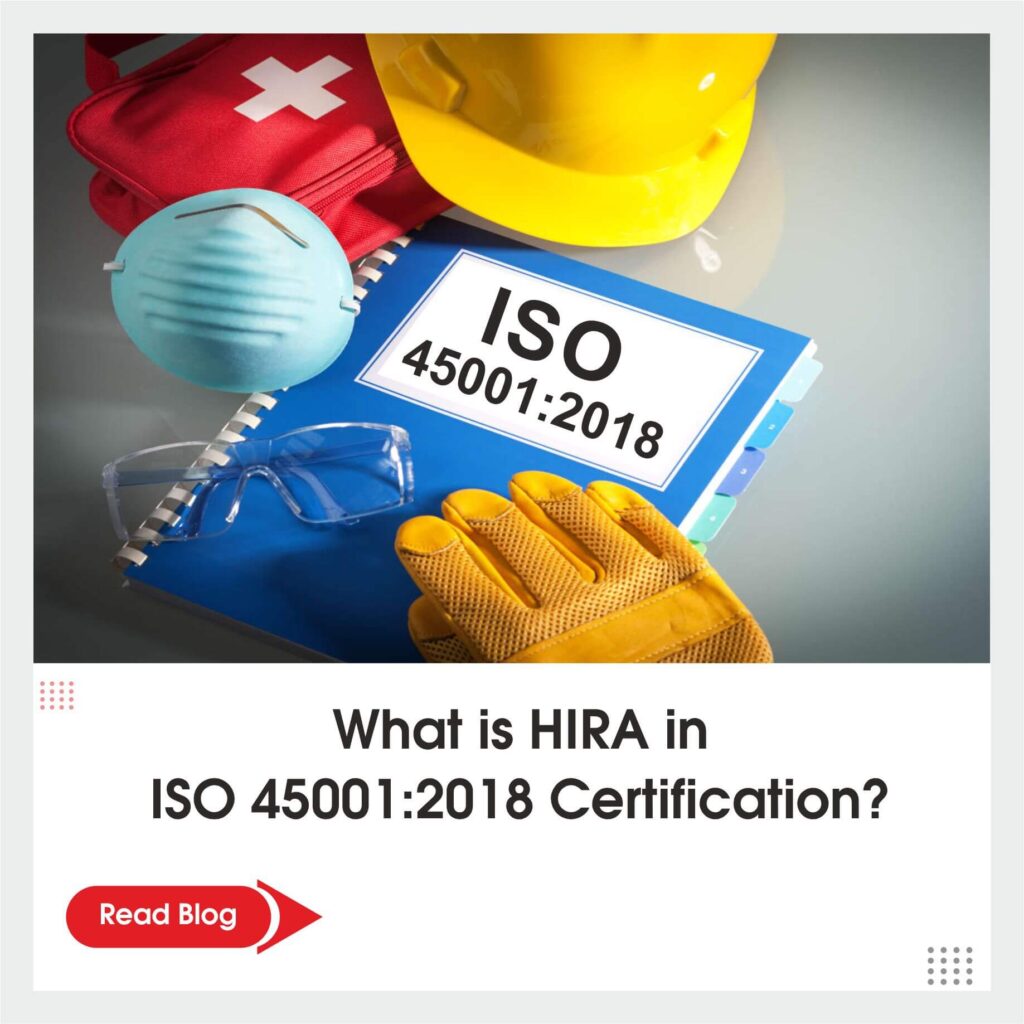
The whole world is talking about and emphasising the significance of HSE; HSE stands for Health, Safety, and Environment. It’s a broad discipline that includes practices, policies, and procedures to protect employees, visitors, contractors, and the environment. Moreover, the S in HSE stands for safety, which aims to reduce hazards, prevent accidents and injuries, and promote sustainable practices. What are the standards for Health and Safety? ⮯ ISO 45001 is an internationally recognized and widely used Occupational Health and Safety Management System (OHSMS). The standard aims to reduce and eliminate work-related injuries, accidents, and diseases to protect employees and visitors. The standard applies to any organization, regardless of size, industry, or geographic location. Moreover, the standard is effective for higher-risk industries like construction, manufacturing, oil and gas, mining, and agriculture. Evolution of ISO 45001 Certification The International Organisation for Standardisation (ISO) has developed the ISO 45001:2018 certification. The standard was proposed in 2007; however, it was published in 2013. So, the first published version of the standard was ISO 45001:2013 certification, and the standard was last updated in 2018. OHSAS 18001 was the first occupational health and safety standard published in 1996. Later, with the introduction of ISO 45001, the Occupational Health and Safety Management System (OHSMS) replaced OHSAS. Elements of ISO 45001:2018 Standard What is HIRA in the ISO 45001 standard? ⮯ Occupational Health and Safety Management System (OHSMS) is a widely used certification to ensure the safety and well-being of employees in an organization. The ISO 45001:2018 standard has a separate clause, Clause 6.1.2.1., to help organizations create a safe and healthy work environment. Moreover, it requires an organization to identify and eliminate the potential work-related risks and hazards to address them proactively. Hazard Identification and Risk Assessment (HIRA) offers a systematic method for evaluating work-related hazards and risks. Moreover, it helps organizations to frame comprehensive metrics for identifying hazards and implementing risk-management strategies. Purpose of Hazard Identification and Risk Assessment (HIRA) It helps organizations recognize all those factors that can cause injuries to workers. The assessment determines potential threats and opportunities to evaluate their severities and address them accordingly. It assesses existing controls and safety measures in the management system to understand their effectiveness. The assessment recommends ISO 45001 controls and measures to manage the potential hazards. Factors that influence Hazard Identification and Risk Assessment (HIRA) ⮯ Continuous improvement in education is a key process that serves to guarantee that children receive the best education possible. This technique entails continuous reviewing and improvement in teaching methods, curriculum, and learning environments to find areas for improvement and make changes to improve student learning results. Continuous improvement is fundamentally about always striving for perfection. It necessitates the establishment of objectives and making improvements as and when required to meet their goals. This type of approach is very significant in education. There are several benefits to exercising a continuous improvement strategy in education. One of the most significant is that it helps children get a high-quality education that boosts their confidence and prepares them to work for their goals. Teachers will get up to date with the latest methods and research by regularly keeping an eye on the teaching techniques and curriculum. Fostering an innovative and collaborative culture among educators is another advantage of continual development. Continuous improvement has the potential to foster a community of educators committed to giving children the best education possible by empowering them to take prudent risks, try out novel strategies, and share their triumphs and disappointments. The promotion of equity in education is arguably the most significant benefit of continuous improvement. Through continuous assessment and improvement of teaching strategies and curricula, educators may spot and close gaps in learning outcomes and guarantee that every student has access to the tools and assistance they require to achieve. Factors that influence Hazard Identification and Risk Assessment (HIRA) The following factors can impact the Hazard Identification and Risk Assessment (HIRA); these are: Workplace or Process Changes: Any changes to the workspace, tools, or procedures could introduce new risks, calling for an evaluation of the HIRA. Occurrence of Incidents: Any incidents or near-misses at the workplace can set off an expeditious HIRA review to pinpoint and rectify the root causes. Adopting Industry Best Practices: A review of the HIRA ensures compliance with current standards to modify occupational health and safety laws to improve risk management techniques. Feedback from Employees: Employee concerns or recommendations regarding potential risks can prompt a thorough review of the Hazard Identification and Risk Assessment (HIRA) to ascertain their validity. Conclusion ✅ An efficient Occupational Health and Safety Management System (OHSMS) must include the HIRA (Hazard Identification and Risk Assessment) process. It helps businesses to eliminate possible risks in the workplace by evaluating risks and creating suitable policies.
VAPT is a mandatory requirement for the Information Technology (IT) Industry
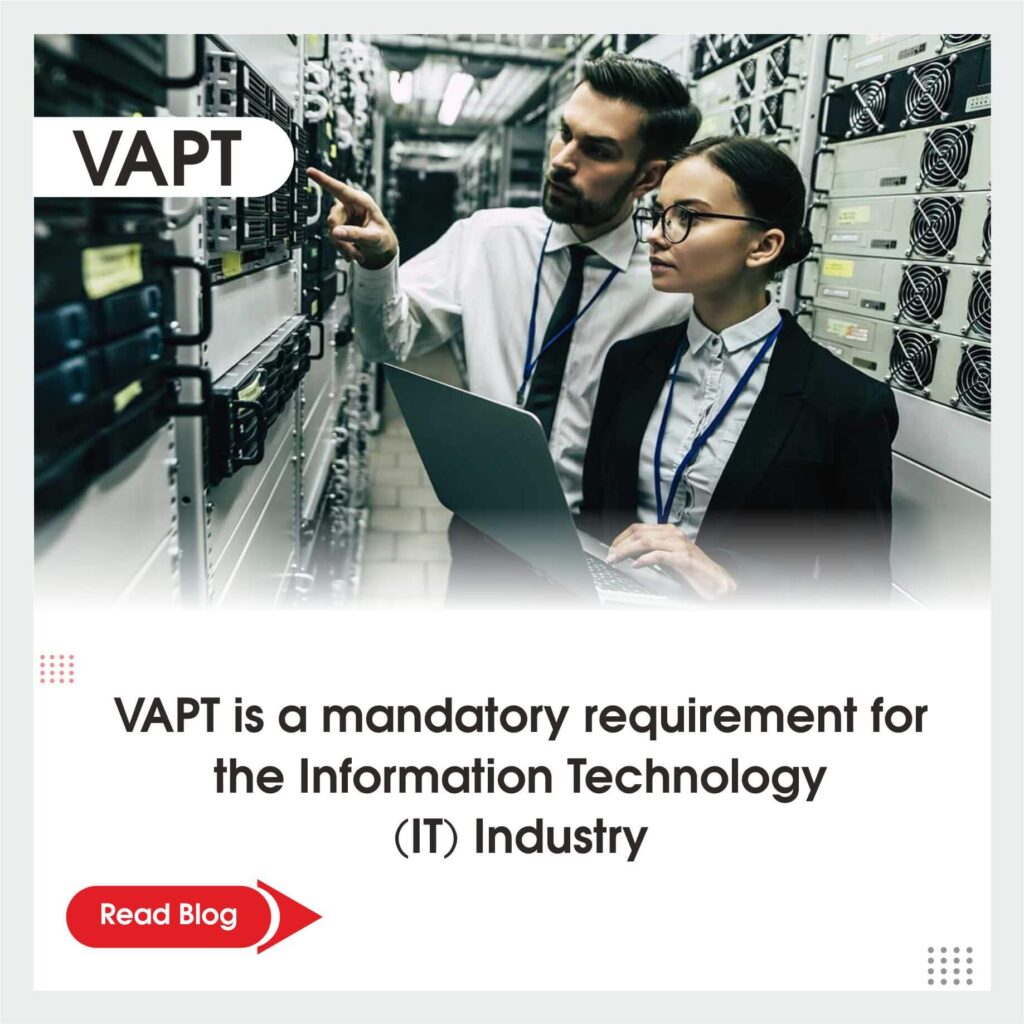
Introduction: Understanding the Importance of Continuous Improvement in Education ⮯ The digital landscape is constantly evolving; hence, it becomes necessary for organizations to build robust Information Technology (IT) infrastructure. The Information Technology (IT) sector amalgamates innovation and interconnectedness to ensure the security of digital assets and confidential data. As organizations become more dependent on digital infrastructure, they become more vulnerable to cyber threats and attacks. Vulnerability Assessment and Penetration Testing (VAPT) is mandatory for the IT industry to safeguard frontline defense against potential cyber-attacks. Benefits of Vulnerability Assessment and Penetration Testing (VAPT) for IT Industries An organization can reap the benefits of VAPT assessment with the ISO 27001:2022 standard. Significance of Vulnerability Assessment and Penetration Testing (VAPT) in the Information Technology (IT) Industry with ISO/IEC 27001:2022 Certification are as follows:- IT Industries must prioritize vulnerability assessment and penetration testing (VAPT) to ensure robust security measures. Moreover, it helps organizations to protect information assets against data breaches and cyber threats. Vulnerability assessment protects valuable data of clients and customers from hackers by identifying potential weaknesses in a network or system. Organizations must conduct a risk assessment to identify potential threats and opportunities to proactively eliminate them and minimize the risk of data breaches from unauthorized access. VAPT simulates real-world attacks to evaluate the effectiveness of existing security controls. Moreover, this process helps identify gaps in network security and strengthen their defenses against cybersecurity attacks. VAPT protects sensitive data along with safeguarding an organization’s reputation. A single data breach can have severe consequences, including financial loss; moreover, it can also damage the brand’s reputation and attract legal implications. IT industries must comply with information security and data privacy regulations such as GDPR (General Data Protection Regulation), ISO 27001, CMMI, SOC-1 and SOC-2 Certification. Moreover, conducting regular VAPT assessments helps organisations comply with international and national regulations and avoid fines and legal penalties. Why is VAPT a mandatory requirement for the Information Technology Industry ? ⮯ The Vulnerability Assessment and Penetration Testing (VAPT) examines the vulnerabilities during the data and information security test. Moreover, the assessment provides adequate measures to protect against cybersecurity threats. It provides organizations with valuable insights into their security posture by detecting areas for immediate attention. ISO 27001 information security standards mandate VAPT for organizations striving to maintain data integrity and protect customer trust. Benefits of Vulnerability Assessment and Penetration Testing (VAPT) for IT Industries ⮯ Data breaches are the most common information security threats experienced by Information Technology (IT) Industries. However, VAPT helps organizations identify and understand the intricacies concerning vulnerable data assets. The consumer is the god and holds immense power to change market trends. As a result, organizations must win clients’ and customers’ trust to expand business and generate more profit. VAPT safeguards the organization’s assets and strengthens customers’ trust by demonstrating a commitment to robust cybersecurity practices. The IT industry operates in a highly regulated environment with stringent compliance standards. VAPT ensures that organizations adhere to these regulations, avoiding legal consequences and financial penalties. Conclusion ✅ Vulnerability Assessment and Penetration Testing (VAPT) is an indispensable tool for identifying and mitigating information security threats and risks. Moreover, the assessment monitors organization compliance with the regulatory and world best practices to protect users’ personal and confidential information.
What are the four pillars of ISO 41001 Certification?
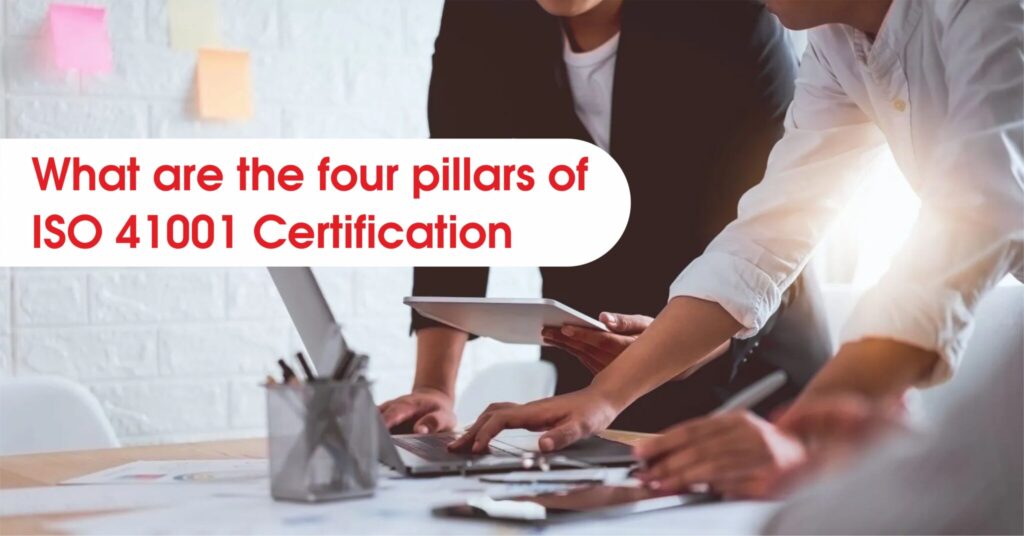
An effective Facility Management System (FMS) is significant to ensure smooth operation in the dynamic business world. The International Organisation for Standardisation (ISO) published ISO 41001 Certification to align and meet the demand for standardised procedures in facility management. Organisations may manage their facilities with the help of ISO 41001 accreditation. The certification follows four core principles to establish a robust and long-lasting facility management system. Four Pillars of ISO 41001 for Facility Management System (FMS) The four pillars of ISO 41001 certification are as follows: ⮯ First Pillar of ISO 41001 – Leadership and Management Leadership and Management is at the core of ISO 41001. Moreover, it highlights the value of healthy leadership commitment and effective management systems to implement facility management practices. The Top Management must establish a clear vision for facility management, aligning it with the organisation’s overall objectives. However, defining roles and responsibilities and allocating resources can help organisations improve their internal working. Comprehensive leadership helps create policies and strategies to address the organisational needs and challenges. The management system must promote principles of accountability, transparency, and collaboration among all stakeholders. Organisations can also instil a sense of purpose and direction by ensuring the facility management aligns seamlessly with the broader business strategy. Second Pillar of ISO 41001 – Operation The operation focuses on the day-to-day activities and processes involved in facility management. Moreover, it highlights the importance of efficiency and sustainability in the operation. Organisations with ISO 41001 certificates must establish and maintain processes to deliver quality services to meet regulatory and occupant requirements. It also focuses on asset management and space utilisation to implement preventive and corrective maintenance measures. However, organisations must assess and optimise resource usage to manage energy consumption and waste management to enhance overall operational performance. Organisations can minimise downtime through systematic planning and execution. Moreover, ensuring effective operations helps to reduce costs and create a safe and comfortable environment for customers, clients, and stakeholders. Third Pillar of ISO 41001 – Performance Evaluation Continuous improvement is the cornerstone of ISO 41001 Certification. It highlights the significance of performance evaluation to assess and enhance the effectiveness of the facility management system. Organisations must establish performance metrics and indicators to monitor and evaluate the overall performance of a Facility Management System (FMS). However, organisations conduct regular audits, inspections, and management reviews to identify areas for improvement and maintain compliance with legal and regulatory requirements. Performance evaluation is a tangible aspect of facility management. However, it also monitors customer satisfaction by taking stakeholder’s feedback to adapt to ever-changing circumstances. Organisations can make informed decisions by systematically reviewing performance data to implement corrective actions. Fourth Pillar of ISO 41001 – Planning Planning lays the groundwork for the successful implementation of ISO 41001. It focuses on strategic planning and risk assessment to develop a robust business continuity framework. Organisations must identify and prioritise the significant aspects of their Facility Management System (FMS) by defining the stakeholders and their needs. Strategic planning involves setting objectives and defining processes by allocating resources to achieve desired outcomes. Business continuity planning ensures that organisations can respond effectively to unforeseen events by causing minimum impact on facility management and maintaining a high level of service delivery. Conclusion ✅ Organisations seeking to improve their facilities management system can use the extensive guidelines provided by ISO 41001 Certification. Organisations can increase productivity and well-being while cutting expenses and improving efficiency by incorporating the four pillars of ISO 41001 into operations. ISO 41001 offers a road map for businesses to adjust to changing business conditions and prosper in the fast-paced field of facility management.
Why is ISO 22000 a Valuable Tool for Minimising Foodborne Hazards?
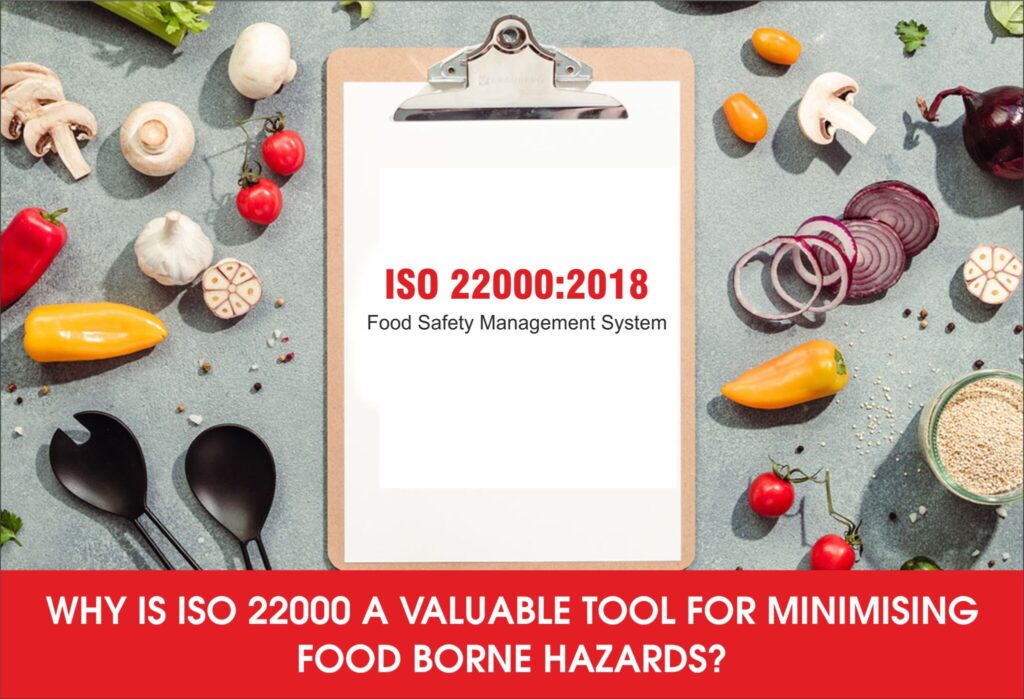
Unsafe or contaminated food can severely affect public health, due to which food producers, consumers, and regulatory agencies have serious concerns about food safety. Moreover, it causes businesses to suffer financial and reputational losses. ISO 22000 is a globally recognised standard for managing food safety management systems. What are foodborne diseases and hazards? Foodborne diseases are illnesses caused by consuming contaminated food. Moreover, these can be due to biological, chemical, or physical agents that can contaminate food and lead to hazards. These hazards can occur at any stage of food production, from farm to table. However, food safety standards provide proper food handling, preparation, and sanitation to prevent foodborne diseases and reduce the risks associated with these hazards. ISO 22000:2018 Certification ISO 22000:2018 Certification is a comprehensive international standard that outlines the requirements for a Food Safety Management System (FSMS). This standard applies to all organizations in the food supply chain, from primary producers to retailers and food service providers. ISO 22000 focuses on preventing and managing food safety hazards by ensuring the safety of the final food product. The standard also follows Hazard Analysis and Critical Control Points (HACCP) and incorporates a risk-based approach to ensure food safety. It provides a framework for organizations to identify, evaluate, and control food safety hazards by ensuring the safety of food products from farm to fork. ISO 22000: A Valuable Tool for Minimising Foodborne Hazards ⮯ The International Organisation for Standardisation (ISO) has developed the ISO 22000 standard to identify risks and hazards related to food safety. Moreover, it also acts a valuable to minimise foodborne hazards and threats in the following ways :- ISO 22000 follows a systematic approach to food safety to establish, implement, and maintain an effective food safety management system. This systematic approach ensures food safety measures throughout the entire food supply chain. ISO 22000 mandates an organisation to identify and evaluate all potential food safety hazards within business operations. Moreover, this includes biological, chemical, and physical hazards. It requires organisations to conduct a thorough hazard analysis and implement preventive measures to minimise the risks associated with these hazards. The standard emphasises the importance of prerequisite programs, such as sanitation, personal hygiene, and pest control, for maintaining a hygienic environment. These programs form the foundation for a robust food safety management system. ISO 22000 incorporates HACCP principles, a systematic and preventive approach to identifying food safety hazards. HACCP involves identifying critical control points in the food production process by establishing controls to prevent or eliminate risks and threats. Effective communication is a significant element of ISO 22000. The standard encourages communication within the organisation and along the food supply chain. Moreover, it ensures that all stakeholders are aware of food safety risks and control measures, helping to prevent foodborne hazards. ISO 22000 promotes a culture of continuous improvement in food safety management. Organisations must regularly review and update their food safety management systems to address emerging hazards and changing conditions. ISO 22000 helps organizations meet legal requirements related to food safety. Businesses can reduce the risk of legal issues, regulatory fines, and product recalls by adhering to this standard and protecting their reputation. ISO 22000 is an internationally recognised and accepted food safety standard. Achieving an ISO 22000 certificate can enhance an organisation’s reputation and open doors to global markets. Many customers and partners prefer to work with ISO 22000-certified food suppliers, as it assures safe food products. ISO 22000 certification instils confidence in customers. When consumers see the ISO 22000 logo on a food product, it builds trust in the high quality of the products. ISO 22000 encourages collaboration within the food supply chain. When all stakeholders, from food producers to distributors, adhere to the same food safety standard, it creates a cohesive approach to minimizing foodborne hazards. The standard requires organizations to establish procedures for emergency response, including potential food safety incidents. Moreover, it can minimise the impact of foodborne hazards when they occur and reduce their impact within the supply chain. ISO 22000 aims to protect the health and well-being of consumers. Organizations contribute to reducing the incidence of foodborne illnesses and related health risks by systematically managing food safety. The primary focus of ISO 22000 is food safety, but it also has economic benefits. The standard Minimises the risk of foodborne hazards and reduces the financial repercussions, legal actions, and damage to an organisation’s reputation in the long term. Conclusion ✅ ISO 22000 is a valuable tool for minimising foodborne hazards due to its systematic and preventive approach to food safety. It emphasises hazard analysis, HACCP principles, and continuous improvement to identify, assess, and control food safety risks. ISO 22000 is a global benchmark for food safety management systems, and its adoption can contribute to the overall sustainability and success of organizations in the food industry.
Everything You Need to Know About Good Manufacturing Practices (GMP)
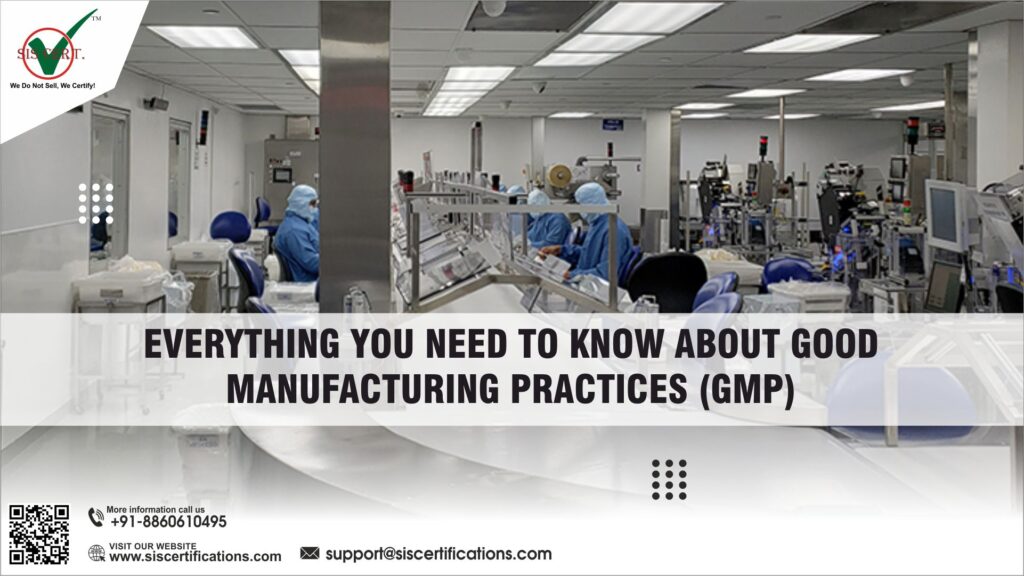
Good Manufacturing Practices (GMP) provides a systematic approach based on rules and regulations for organisations to achieve intended outcomes. Moreover, it ensures the manufacture of safe and high-quality goods consistently across diverse industries, including the food, pharmaceutical, and cosmetics sectors. In this blog, we will cover everything about GMP, from its significance to its guiding principles and methods. What is Good Manufacturing Practices (GMP)? Good Manufacturing Practices (GMP) is a quality measuring system. Moreover, it describes the rules and guidelines necessary for organisations, from production and testing to the distribution of goods. GMP seeks to reduce production hazards by conducting a risk assessment to eliminate potential risks and testing the finished product. It is significant for products which directly impact consumers’ health and safety. Importance of Good Manufacturing Practices (GMP) Good Manufacturing Practice (GMP) is essential for ensuring the quality and safety of pharmaceutical products. Furthermore, it demonstrates an organisation’s dedication to guidelines for manufacturing processes and maintaining regulatory compliance. It offers a goldmine of benefits to an organisation; these are: Benefits of Good Manufacturing Practice (GMP) ⮯ GMP ensures the safety and quality of products by minimising the risk of contamination, adulteration, and other quality issues. Moreover, this directly safeguards consumer health and well-being. GMP ensures consistent product quality by establishing stringent standards and procedures and helps companies maintain their reputation and customer trust. Many regulatory agencies, such as the FDA (Food and Drug Administration) in the United States and the EMA (European Medicines Agency) in Europe, require companies to adhere to GMP guidelines. However, Non-compliance to GMP regulations can lead to legal and financial consequences. Implementing Good Manufacturing Practices (GMP) can reduce the likelihood of costly product recalls, fines, and legal disputes, ultimately saving companies money. Principles of Good Manufacturing Practice (GMP) ⮯ The Eight principles of Good Manufacturing Practices (GMP) are as follows :- Documentation – It provides a comprehensive and accurate documentation approach for various business processes and procedures. Moreover, this includes batch records, standard operating procedures (SOPs), and quality control documents. Personnel – GMP guidelines mandate organisations to provide employees with proper training and hygiene practices to prevent contamination and ensure product quality. Facilities and Equipment – It states that adequate facilities and well-maintained equipment are necessary to maintain a clean and controlled manufacturing environment. Process Control – GMP focuses on consistency in manufacturing processes through strict process control measures, ensuring each batch meets quality standards. Raw Materials – The quality and source of raw materials are closely monitored and controlled to prevent contamination or adulteration. Packaging and Labelling – It follows appropriate packaging and labelling practices to manage mix-ups by ensuring accurate product information. Quality Control and Testing – GMP follows rigorous quality control and testing procedures at various stages of production to verify product quality. Records and Traceability – GMP mandates organisations to maintain detailed records of each batch to enable traceability. Which industries can apply for Good Manufacturing Practices (GMP) Certification? A list of industries that can apply for GMP Certification: Pharmaceuticals Food and Beverage Cosmetics Medical Device Herbal and Dietary Supplements Implementation of Good Manufacturing Practices (GMP) Certification Organisations can follow these steps to implement Good Manufacturing Practices (GMP) Certification. These are: An organisation must assign a team responsible for GMP compliance and training. Organisations must create and document GMP procedures tailored to their specific industry and product needs and requirements. Good Manufacturing Practices (GMP) provide thorough training to employees on GMP principles, hygiene, and procedures. It mandates organisations to conduct regular internal audits and inspections to identify and rectify compliance issues. Continuous Improvement is an integral principle that monitors and improves GMP practices based on feedback and evolving industry standards. Conclusion ✅ Companies can obtain Good Manufacturing Practices (GMP) to win consumers trust and confidence. Moreover, it demonstrates an organisation’s commitment to safety and product quality by meeting quality regulations and GMP principles. Understanding and using GMP is essential for success and public trust, regardless of whether you are in the pharmaceutical, food, cosmetic, or any other business. Enjoy Reading – Guide For Food Safety Certifications
